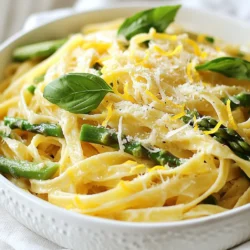
Lemon Parmesan Asparagus Pasta
A delightful pasta dish featuring fresh asparagus, lemon, and Parmesan cheese.
Ingredients
- 8 oz fettuccine or tagliatelle pasta
- 1 lb fresh asparagus, trimmed and sliced into 2-inch pieces
- 2 tablespoons extra virgin olive oil
- 3 cloves garlic, finely minced
- 1 large lemon, zest
- 3 tablespoons fresh lemon juice
- 1 cup freshly grated Parmesan cheese
- to taste salt
- to taste freshly ground black pepper
- optional fresh basil leaves for garnish
Instructions
- Cook the Pasta: Begin by bringing a large pot of salted water to a rolling boil. Once boiling, add the fettuccine or tagliatelle and cook according to the package instructions until the pasta reaches an al dente texture. Before draining, reserve 1 cup of the starchy pasta cooking water. Drain the pasta and set it aside.
- Blanch the Asparagus: In a separate pot, fill it with water and bring it back to a boil. Carefully add the chopped asparagus and blanch for 2-3 minutes, or until the asparagus is bright green and tender-crisp. After that, drain the asparagus and swiftly transfer it to a bowl filled with ice-cold water. This will halt the cooking, preserving its vibrant color and crunch. After a few minutes, drain the asparagus again.
- Sauté the Garlic: Heat the extra virgin olive oil in a large skillet over medium heat. Once hot, add the minced garlic to the skillet. Sauté for about 1 minute, stirring constantly, until the garlic becomes fragrant but avoid letting it brown, as this can impart a bitter flavor.
- Combine Ingredients: Add the blanched asparagus to the skillet with the sautéed garlic. Cook together for an additional 2 minutes, stirring occasionally, to combine the flavors and heat the asparagus through.
- Mix with Pasta: Gently fold the drained pasta into the skillet along with the lemon zest, lemon juice, and half of the grated Parmesan cheese. Toss everything together thoroughly. If the mixture seems dry, gradually add small amounts of the reserved pasta water to create a light, creamy sauce that beautifully coats the pasta.
- Season: Season your pasta dish with salt and freshly ground black pepper, adjusting to your taste. Continue tossing until all ingredients are well combined and everything is heated through.
- Serve: Spoon the pasta into serving bowls, garnishing generously with the remaining Parmesan cheese and fresh basil leaves if using, for a fresh pop of color and flavor.
Notes
For an elegant touch, consider drizzling a little extra olive oil over the top just before serving. A few cherry tomatoes can also be added for a splash of color. Enjoy!